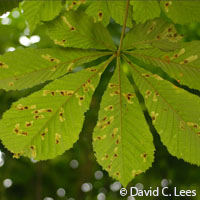Trails tell tails of how leaf miners conquered Europe
The leaf miner, Cameraria ohridella, still unknown three decades ago, has spread throughout the whole of central Europe. The insect made its way north, west and east by truck and rail. Fighting it seems impossible. However, the experts are pinning their hopes on finding its geographical origin so that its natural enemies can be used to combat this invasive species. Writing in the journal Frontiers in Ecology and the Environment, an international team of researchers, led by Dr David Lees from Institut National de la Recherche Agronomique (INRA) in France and H. Walter Lack from the Freie Universität Berlin in Germany, has shown that the leaf miner populations present in Europe originate from the Balkan Peninsula. Determining the origin of the leaf moth was not a simple affair. Out of more than 1,500 species of invertebrates considered to be non-native to Europe, some 220 species still have an unknown origin. Increasing numbers of non-native species continue to be introduced, because of the intensity of international trade and the number of people travelling throughout the world. Only a small proportion manages to install themselves long-term in new regions, and then start to reproduce. Biological invasions are generally initiated by a few 'pioneer' individuals. These founders represent only a small fraction of the overall genetic diversity present in the original population. The researchers collected samples of Cameraria ohridella from parks and gardens in Europe; these were analysed genetically and compared with populations sampled from forests of the Balkan mountains. The genetic diversity of populations was found to be significantly higher in these natural forests. This finding and the closeness of the populations suggested that Cameraria ohridella originates from the southern Balkans. Furthermore, using a combination of nuclear and mitochondrial DNA from larvae pressed within leaves of herbarium samples collected as early as 1879, they were able to trace its history in Europe as far back as the 19th century. Much to their surprise, leaf miner Cameraria ohridella was found to have thrived in central Greece and Albania back in 1961, long before the species was first discovered. In central Europe first records have been made in Austria in 1989. The following years saw a rapid invasion into surrounding countries. Today, Cameraria ohridella is widespread all over Europe where it lays eggs on the leaves of horse chestnuts and the caterpillars make mines in the leaf tissue a few millimetres long. This sounds like a very weak threat to the towering and majestic trees that are not starting to develop the familiar conkers (horse chestnuts). Cameraria ohridella may be tiny, silent and inconspicuous, yet it leaves a trail of destruction in its wake in early summer. From the tiny eggs that the females lay on the leaves in spring, the larvae relentlessly eat their way through the leaves of chestnut trees, threatening parks and gardens with autumnal leaf shedding in the middle of summer. The leaves are literally eaten. The larvae shed their skins several times and pupate in a cocoon out of which the moth later hatches and provides for a new generation. Up to four generations develop in one summer; the larvae of the last generation hibernate in the leaves. The foliage becomes dry and falls off long before autumn.For more information, please visit:Freie Universität Berlin:http://www.fu-berlin.de/Frontiers in Ecology and the Environment:http://www.esajournals.org/loi/fron
Countries
Germany, Greece, France, United Kingdom, United States



